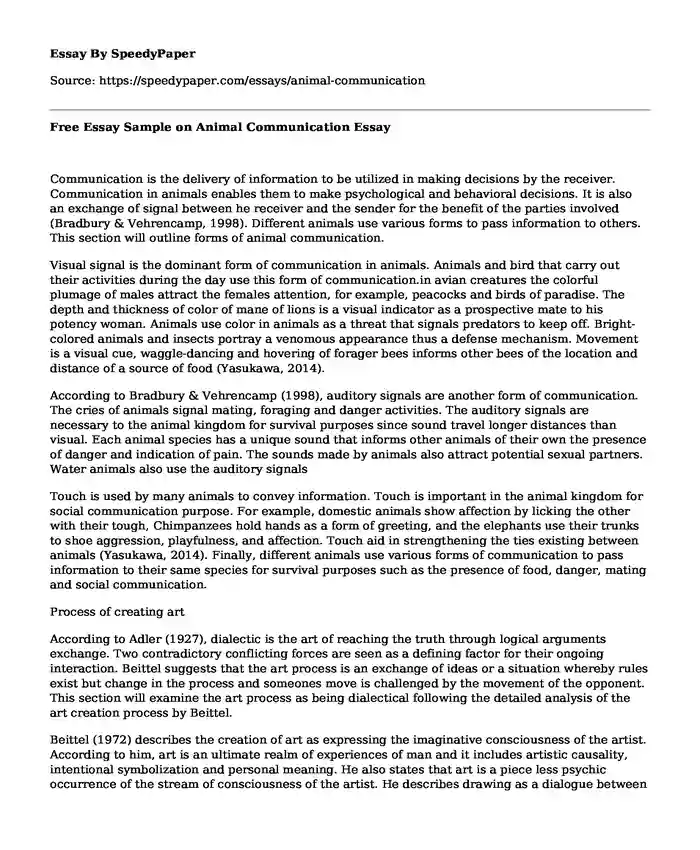Communication is the delivery of information to be utilized in making decisions by the receiver. Communication in animals enables them to make psychological and behavioral decisions. It is also an exchange of signal between he receiver and the sender for the benefit of the parties involved (Bradbury & Vehrencamp, 1998). Different animals use various forms to pass information to others. This section will outline forms of animal communication.
Visual signal is the dominant form of communication in animals. Animals and bird that carry out their activities during the day use this form of communication.in avian creatures the colorful plumage of males attract the females attention, for example, peacocks and birds of paradise. The depth and thickness of color of mane of lions is a visual indicator as a prospective mate to his potency woman. Animals use color in animals as a threat that signals predators to keep off. Bright-colored animals and insects portray a venomous appearance thus a defense mechanism. Movement is a visual cue, waggle-dancing and hovering of forager bees informs other bees of the location and distance of a source of food (Yasukawa, 2014).
According to Bradbury & Vehrencamp (1998), auditory signals are another form of communication. The cries of animals signal mating, foraging and danger activities. The auditory signals are necessary to the animal kingdom for survival purposes since sound travel longer distances than visual. Each animal species has a unique sound that informs other animals of their own the presence of danger and indication of pain. The sounds made by animals also attract potential sexual partners. Water animals also use the auditory signals
Touch is used by many animals to convey information. Touch is important in the animal kingdom for social communication purpose. For example, domestic animals show affection by licking the other with their tough, Chimpanzees hold hands as a form of greeting, and the elephants use their trunks to shoe aggression, playfulness, and affection. Touch aid in strengthening the ties existing between animals (Yasukawa, 2014). Finally, different animals use various forms of communication to pass information to their same species for survival purposes such as the presence of food, danger, mating and social communication.
Process of creating art
According to Adler (1927), dialectic is the art of reaching the truth through logical arguments exchange. Two contradictory conflicting forces are seen as a defining factor for their ongoing interaction. Beittel suggests that the art process is an exchange of ideas or a situation whereby rules exist but change in the process and someones move is challenged by the movement of the opponent. This section will examine the art process as being dialectical following the detailed analysis of the art creation process by Beittel.
Beittel (1972) describes the creation of art as expressing the imaginative consciousness of the artist. According to him, art is an ultimate realm of experiences of man and it includes artistic causality, intentional symbolization and personal meaning. He also states that art is a piece less psychic occurrence of the stream of consciousness of the artist. He describes drawing as a dialogue between the drawer and his drawing thus; it is a covert. Drawing series leads to self-direction especially in little chance in the theme, medium, self-evaluation procedure and stimulus.
Art arises as a result of motor acts series with one prompting the other, dependent on former acts, contingent on on-going perception, a progression in which choice in connection to intent takes place at the transformational operations level. The artist decode his images for expression purposes (Beittel, 1972) Art is a form of communication. Various feedbacks occur in the process of drawing; thus, representation of phenomenon for evaluation and comments is an intensification process. The contradiction between unique situations and processes and plans evoke the artists mind in his drawings giving rise to a piece of unique art.
Finally, the art process is a dialectical process thrilled by the incongruity of opposites. The line which generates a valid ground paves a way to the remaining opposing ground which induces a new contrasting figure. A simple form stimulates development and elaboration. Precision evokes grace; restraints, spontaneity; struggle, passion; variation and theme. Art composes of contradicting entities which evoke its continuity.
References
Adler, M. J. (1927). Dialectic. London: K. Paul, Trench, Trubner & Co.
Beittel, K. R. (1972). Mind and context in the art of drawing: An empirical and speculative account of the drawing process and the drawing series and of the contexts in which they occur. New York: Holt, Rinehart and Winston.
Bradbury, J. W., & Vehrencamp, S. L. (1998). Principles of animal communication. Sunderland, MA: Sinauer Associates.
Yasukawa, K. (2014). Animal behavior: How and why animals do the things they do. Santa Barbara: ABC-CLIO.
Cite this page
Free Essay Sample on Animal Communication. (2019, Sep 09). Retrieved from https://speedypaper.net/essays/animal-communication
Request Removal
If you are the original author of this essay and no longer wish to have it published on the SpeedyPaper website, please click below to request its removal:
- Free Essay in Edication: My Biggest Academic Challenge
- Essay Example on Space Mission (Mars Curiosity)
- FUNCOVER Ltd: Free Essay on Organizational Culture
- Free Essay: Religion and Science on BBC One's 'Call the Midwife.'
- Essay Sample on Substance Abuse and Mental Health Counseling
- Essay Sample on Homer's Society
- Free Essay Sample on Mozart's Suspicious Death
Popular categories





